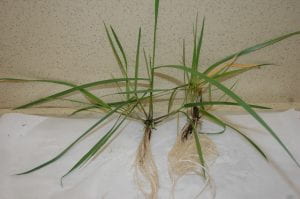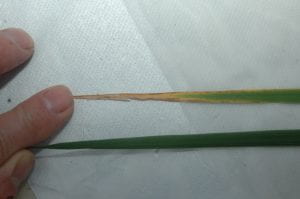Richard Taylor, Extension Agronomy Specialist; rtaylor@udel.edu and Amy Shober, Extension Nutrient Management and Environmental Quality Specialist; ashober@udel.edu
In a survey this past year, readers expressed their desire to have more articles about nutrient deficiencies included in the Weekly Crop Update. Over the next few issues, we will present information about nutrient deficiencies and provide readers with photos to use as visual aids when trying to diagnose nutrient-related field problems.
Most of us find that identifying nitrogen (N) deficiency on field corn is relatively easy to do, but how many growers could identify the same deficiency on the typical forage grasses used in Delaware. Unlike corn, that shows a distinctive inverted V area of yellowing (chlorosis) from leaf blade tip back towards the leaf collar on the oldest leaves, the forage grasses (tall fescue, timothy, orchardgrass, and reed canarygrass) can exhibit the inverted V, a regular V, or even a diffused area of chlorosis when the deficiency becomes severe. A more typical symptom of N deficiency of forage grasses is a lack of tillering, rhizome or stolon development, and slow growth. In most cases, lower yield at a cutting is the primary symptom of N deficiency that is observed by the producer. Since lower yields can be the result of numerous factors, such as moisture, disease or weed pressure, N deficiency might not even be considered.
The following photos illustrate the range in N-related chlorosis symptoms that can be seen on the oldest (lowest) leaves and how the lack of N affects root, shoot, leaf, and tiller production. The take home message, as shown in the photos, is that yield reduction due to N deficiency very likely occurs long before a grower or consultant will see distinct and visible leaf yellowing symptoms. A regular N management program is essential to maintain yield of the forage grasses whether grown for hay or pasture. Tissue sampling and testing, done in conjunction with a routine soil testing program, can help producers achieve maximum forage yields.
Click on the photo for a larger version.
Tall Fescue
Orchardgrass
| Tillering |
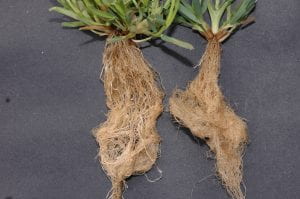
Many fewer tillers are produced on a N deficient plant (plant on the right) than for a plant with all nutrients available.
In the photo under root growth, phosphorus deficiency shows a similar reduction in tiller number but a potash deficient plant’s ability to produce tillers seems unaffected or at least not much reduced |
| Root Growth |
 
The root system in a N deficient orchardgrass plant, is smaller than that of the plant growing in sand and watered with a complete nutrient solution. |
| Leaves/ Top Growth |
 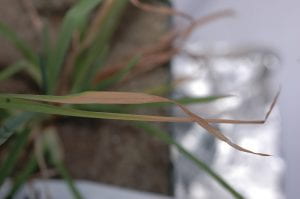
Leaf chlorosis for N deficient orchardgrass is very irregular rather than the traditional inverted V shaped yellowing seen in corn or even tall fescue. |
Timothy
| Tillering |

The N deficient timothy plant is on the right and failed to tiller over the 5 month growing period. The plant grown with N did produce four additional tillers in addition to the main shoot that flowered, was clipped and then died. |
| Root Growth |

The above photo shows timothy with all required nutrients (on the left) and then deficient in N, P, and K. The root mass is greatest for the complete and the minus potash treatments with fewer roots produced where N or P are deficient. Roots for the plant with all required nutrients tended to be larger or coarser than those where one of the major elements was deficient. |
| Leaves/ Top Growth |
 
In the top photo, it appears that timothy produces the typical inverted V chlorotic area when N is deficient but as seen in the second photo, the symptoms are variable. On one leaf, just the tip of the leaf blade shows the yellowing and in another the yellowing is more diffuse and less in a distinct V shape. |
Reed Canarygrass
| Tillering/Rhizome Development |
  The top photo shows N deficient reed canarygrass on the right and the bottom photo shows reed canarygrass grown with all essential nutrients on the left and then deficient in N, P, and K going left to right. There’s a significant increase in the number of tillers in the plant with all nutrients. In the photo for root growth, it can be observed that rhizome development was severely inhibited by the lack of nitrogen. The top photo shows N deficient reed canarygrass on the right and the bottom photo shows reed canarygrass grown with all essential nutrients on the left and then deficient in N, P, and K going left to right. There’s a significant increase in the number of tillers in the plant with all nutrients. In the photo for root growth, it can be observed that rhizome development was severely inhibited by the lack of nitrogen. |
| Root Growth |
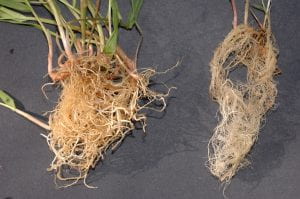 As with the other forage grasses, the root system for reed canarygrass grown with all essential elements is larger and roots are coarser than the plant deficient in nitrogen. As with the other forage grasses, the root system for reed canarygrass grown with all essential elements is larger and roots are coarser than the plant deficient in nitrogen. |
| Leaves/ Top Growth |
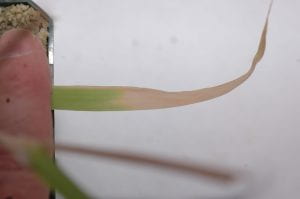 The entire reed canarygrass leaf was less green than where N was supplied to the plant and the chlorotic area was more diffuse and didn’t show the typical inverted V shape seen in corn. Top growth for all species was severely limited when N was absent but until leaf N deficiency symptoms develop, the reduction in top growth might be attributed to a number of factors. The entire reed canarygrass leaf was less green than where N was supplied to the plant and the chlorotic area was more diffuse and didn’t show the typical inverted V shape seen in corn. Top growth for all species was severely limited when N was absent but until leaf N deficiency symptoms develop, the reduction in top growth might be attributed to a number of factors. |

